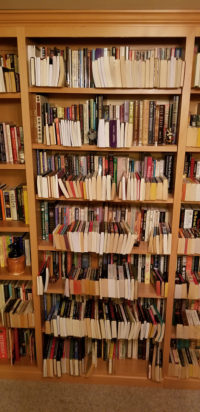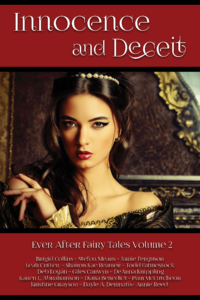Interview: Stefon Mears on “The Fennigsan’s Challenge”
“The Fennigsan’s Challenge” is in Innocence and Deceit, the second volume in the Ever After Fairy Tales anthology series.
Enter the magical, unpredictable, wonderful world of fairy tales!
Meet Stefon Mears!
Stefon began reading with children’s versions of Greek and Norse myths, and quickly graduated to authors like Tolkein and Moorcock, and then to playing Dungeons and Dragons. Today he writes fantasy and science fiction, collects books on the occult, and entertains his cats.
“The Fennigsan’s Challenge”
Lloxup is robbed and left for dead, and then comes across the Fennigsan, the legendary Dark Lady of the Woods. If he passes her challenge, her power could change his life. But failure means death.
Excerpt
“Tell me, Lloxup of Lliost Reach, suppose I offered you the prize you seek without facing the challenge. And I said that all you had to do was offer me your manservant for my supper pot.
“What would you say to that?”
“Take the deal,” said Torvius quickly. “We’re both dead the other way—”
“Silence, manservant!” The Fennigsan’s voice cracked like fire snapping a huge log. “I asked the noble.”
“His name is Torvius, not manservant,” said Lloxup, forcing himself to stand straight without the cane and gritting his teeth against the fiery pain in his knee. He held the cane like a weapon, but not yet menacing. “And I have come for your challenge, but I would sooner die myself than sacrifice him.”
“Yes,” the Fennigsan said softly with a series of slight nods. “I believe you would.” She drew a deep, rickety breath and said, “All right, fourth son of a duke, you may face my challenge.”
She turned to Torvius. “And you may leave.”
“I will not abandon him,” said Torvius.
“Have a care. If you fail I shall claim you both for my pot, but if you succeed only one can claim the prize.”
Torvius stepped up behind Lloxup in a show of solidarity.
“Very well,” said the Fennigsan, with another cackle. “More meat for my pot.”
—from “The Fennigsan’s Challenge” by Stefon Mears
The Interview
Lloxup, the protagonist in “The Fennigsan’s Challenge,” has to accomplish tasks to achieve a goal—and the price of failure is death. What inspired you to create this incarnation of a familiar fairy tale trope?
Fairy tales, myths and legends have always been part of my life, going back before I was reading for myself. It was simply inescapable that when I started writing, I’d need to tell some of my own versions of such stories. In fact, the first short story I ever had picked up by a magazine was “Bedfellow,” a modern fairy tale about three young CEO’s out to win the favor of a mighty senator. I’ve also written my own update of the occasional folk tale, such as On the Edge of Fairie, a modern update of the Scottish tale in Tam Lin, set on the California coast.
When it came time to write “The Fennigsan’s Challenge,” I wanted to do a slight twist on a traditional fairy tale form. A guy who’d already tried to make his fortune, and failed. A man at the end of his rope, meeting an old woman who wasn’t out to help him, but might anyway…
What difference do you see between today’s fairy tale retellings, and the types of fairy tales that were told hundreds of years ago?
Whuf. My first thought is that this kind of analysis deserves a graduate thesis to be done proper justice.
I’ll try to say something brief but still useful though.
A big difference between the old fairy tales and the modern retellings is that the modern retellings are instantly fixed. The old tales started in the oral tradition. They would change a bit from town to town and region to region, with mainly the core elements staying intact and the details changing to suit the location.
If there was a forest in the story, it would be the forest near the town where the story was told. It gave the stories an immediacy for the listeners.
That kind of oral storytelling still exists, but it’s on the periphery of modern American society, rather than central. More often, we write our stories down, which fixes the sense of where they happened. There’s an advantage in the sense that the stories can spread farther and wider, and be enjoyed in precisely the way the writer intended. But that immediacy and connection is lost.
Traditional fairy tales varied depending on where the tellers lived. For example, Scandinavian fairy tales often included characters and elements related to their landscape. Is there a geographical region whose fairy tales resonate with you? And if so, why?
I grew up mostly with the Celtic and the Germanic fairy tales, including some family variations on the classics.
Though speaking of geographical elements, I’ve always found forests especially inspiring. It’s part of the reason that I moved to the Pacific Northwest, where I can be surrounded by vast forests anytime I want.
Is there a fairy tale that you really enjoy, or which has stuck with you? If so, which one—and what do you find compelling about this particular story?
If I had to pick one, I’d probably say Tam Lin. A human in love with a sidhe, plus the shape shifting aspect of the story. All of it, really. In fact, I suspect that this tale inspired one of the major characters of the Rise of Magic series. I’d say which one, but it would be a spoiler.
Your series Rise of Magic is set six decades after magic overthrew technology. what’s your favorite part of writing in this universe?

Just one thing? Oh, that’s a tough choice. I think it’s got to be this.
I wasn’t much more than a kid when I borrowed Randal Garrett’s Lord Darcy books from my brother’s girlfriend. They’re mysteries, set in an alternate timeline where magic ascended hundreds of years prior, back in the era of Richard the Lionheart. Physical sciences took a backseat to organized magic.
Lord Darcy himself is a Sherlock Holmes type of character, and his Dr. Watson is a forensic sorcerer by the name of Master Sean O’Lochlainn.
I was enthralled by the world Garrett portrayed in a single novel and two short story collections. My Rise of Magic universe is nothing like his, but his work absolutely inspired me to create it.
And somewhere inside me, the kid who borrowed those books thrills every time I sit down to write another Rise of Magic tale.
You have a large collection of books about the occult. How have these books helped with your Spells for Hire series?
That’s actually kind of backwards. It’s more that writing Spells for Hire books gives me an excuse to draw on my vast occult library.

I’m pretty sure all writers think about human nature. Some come at it from the angle of psychology or sociology. I’ve always started with people’s belief systems. It’s the reason that my undergraduate degree is in Religious Studies, with a double emphasis in Mythology and Ritual.
But I think there’s even more to learn from the magical practices of this world. They have a lot to teach about goals, interpersonal relationships, priorities, and more.
Most of what I draw on for the Spells for Hire series is Hoodoo and Conjure, of course. After all, the main character is a Hoodoo man. And I always have a few relevant books handy when writing those stories.
Along similar lines, the Rise of Magic series draws significantly on Western Ceremonial Magic (or Magick, if you prefer), albeit with a fictitious spin. Especially the Enochian work of Dr. John Dee and Edward Kelly. That’s a fun system to use for fiction, because even most people who know about it, don’t really know it well.
You’ve engraved your own set of Norse runes. 🙂 Why?
I’ve made a deep study of the Norse runes. They’re heavily entrenched in both Norse myth and Norse magical practices. (Well, and to a lesser extent, in Celtic myths and magic as well, through the Ogham script, but this question was about the runes). I have about a dozen books on the runes alone, both historical and what R.I. Page would call “imaginative.”
Engraving my own set of the Elder Futhark runes was part of that study.
What story (or stories) are you working on now, and what’s fun about what you’re writing?
I’ve learned the hard way that admitting what I’m writing currently tends to hamstring me. Just one of those weird mental quirks. I can tell you that I’ve recently completed the next Spells for Hire books, and it should be out this summer.
The most fun for me in that one was writing Heath’s grandmother, who has come to town for a visit…
About Stefon
Stefon Mears grew up in California, Middle-Earth, and Amber. He went to U.C. Berkeley intending to major in Genetics, but the call of storytelling compelled him to graduate with a B.A. in Religious Studies (double emphasis in Mythology and Ritual). He later earned an MFA in Creative Writing from the Northwest Institute of Literary Arts, with a Fiction major, and has published many short stories, poems and essays.
Stefon has been an invited guest at a major Vodou ceremony in New Orleans, taught classes in the Brazilian martial art of Capoeira, spoken on a panel at one World Fantasy Conference and given a reading at another, and engraved his own set of Norse runes.
Stefon has worked as a professional audio engineer and played straight pool for money. He is an avid, lifelong fan of the San Francisco Giants. He lives in Portland, Oregon, with his wife and three cats, and when not writing he can often be found playing role playing games.
Find Stefon
Website ~ Facebook ~ Twitter ~ BookBub ~ Amazon ~ Goodreads
Find Innocence and Deceit
Amazon ~ Barnes & Noble ~ Kobo ~ Apple Books ~ Books2Read ~ Goodreads



One Comment
Comments are closed.